Design of a Methodology to Evaluate the Energy Flexibility of Residential Consumers to Enhance Household Demand Side Management: The Case of a Spanish Municipal Network
Abstract
1. Introduction
2. Methodology
- Analyze consumption data based on standard data obtained from the network operator. A monthly and daily analysis will be the case.
- Identify consumption patterns by estimating the probability of occurrence of each end-use over the 24 h of the day of the aggregated residential consumers.
- Identify consumption patterns by estimating the likelihood of each end-use occurring over the 24 h of the day.
- Identify the geographical, demographic, and climatic context in which the study occurs and the location of the town of Crevillente.
- Apply the methodology to real data from the four transformer substations in Crevillente to validate the tool and quantify the effects in a real-world scenario.
2.1. Study Area and Local Contex
2.2. Consumption Analysis
2.3. Consumption Characterization
- Heating:
- –
- Reversible heat pumps
- –
- Non-reversible heat pumps
- –
- Electric heaters
- –
- Electric convectors
- –
- Electric radiators
- –
- Electric boilers
- Domestic Hot Water:
- –
- Electric water heaters
- Refrigeration:
- –
- Air conditioners
- –
- Reversible heat pumps (in cooling mode)
- –
- Refrigerators
- –
- Freezers
- Cooking:
- –
- Electric stoves
- –
- Ceramic hobs
- –
- Induction cooktops
- Household Appliances:
- –
- Washing machines
- –
- Dishwashers
- –
- Televisions
- –
- Clothes dryers
- –
- Ovens
- –
- Appliances in stand-by mode
- Other electrical equipment:
- –
- Hair dryers
- –
- Gaming consoles
- –
- Audio systems
- Initial Consumption Values: The annual consumption values for each end use (Lighting, Heating, etc.) are given by the sum of the values for each month and are determined by the reference percentages (Figure 1).
- Monthly Constraints: For each month, the sum of the consumption across all end uses must match the total monthly consumption in kWh.
- Inconsistency Issue: If the initial consumption values for each category are too rigid or inflexible, they might not satisfy the total monthly consumption constraints.
Mathematical Approach to the Solution
- Solar Radiation Condition: The lighting is on (L(t) = 1) if the solar radiation is below a certain threshold, R(t) < 50 W/m2. This represents a low natural light condition.
- Nighttime Condition: Even if R(t) < 50 W/m2, the lighting is off (L(t) = 0) during the nighttime hours (from 1:00 AM to 6:00 AM), assuming that people sleep and, therefore, do not need lighting. This time range has been assumed uniform for the whole annual period. However, it could be adjusted by considering the sunrise and sunset times throughout the year. Nevertheless, changing this time range would not significantly affect the final results.
2.4. Identification of Consumption Patterns
- For each graph related to appliance consumption, the maximum power value was identified and assigned a maximum usage relative frequency of 1 (100%). When there is no consumption, the power value is associated with a usage relative frequency of 0 (0%). In this way, a reference scale was created for each graph, which is useful for calculating relative frequencies for each time slot.
- The day was divided into hourly time slots. For each time slot, the resulting relative frequency range was calculated.
- The calculated range was taken as a reference to represent the variability in consumption. In fact, to introduce variability between different households, for each hour of the day and for each household, a random relative frequency value was generated within the calculated range. This allowed for the simulation of a more realistic and representative distribution of electricity consumption, reflecting the natural variability of consumer behavior based on home occupancy, the number of people present, and consumption variations related to whether the day is a weekday or holiday.
- This process was repeated for all end uses mentioned in the article [45].
- To obtain the probability of usage for each hour h, the value of the relative frequency fh for each hour must be divided by the sum of all relative frequencies over the 24 h of the day:
- Tref is the reference temperature (the temperature at which the respective heating or air conditioning systems are activated).
- Tamb is the ambient temperature measured at a specific time. The greater the difference ∆T, the higher the probability of heating usage. If Tamb > Tref, meaning when the ambient temperature exceeds the reference temperature, ∆T = 0 is set, and thus the probability of heating usage becomes zero.
2.5. Total Energy Consumption Across All Households
- Construction of the probability matrix: For each end use, a matrix was created where
- The rows correspond to the 24 h of the day (h = 1, 2, …, 24).
- The columns represent the households (i = 1, 2, …, C).
Each cell Ph,i of the matrix contains the probability that the end use is activated at hour h in house i. - Sum of probabilities for each hour: For each hour of the day, the sum of probabilities across all households was calculated. The sum of probabilities for hour h is given by
- Determination of total daily consumption: The total daily consumption for a single household is known from the TSO data. This value, denoted as Etot_house, is multiplied by C to obtain the total daily consumption for all the households, assuming that the consumption is approximately the same across all households:This value represents the households’ total consumption on a specific day (e.g., January 1st).
- Application of the ratio of consumption for each end use: Each end use has its ratio of consumption based on the month and the type of use. This value, denoted as %(M), represents the share of energy allocated to that specific end use in month M. Therefore, the specific daily consumption for that end use is given by
- Distribution of consumption for each hour: To obtain the hourly E(h) related to each end use, the following calculation was used:where
- Psum(h) is the sum of the probabilities for hour h across all households.
- represents the total sum of probabilities over all hours and all households.
- Eend_use is the total daily consumption for the specific end-use calculated earlier.
- Results: By repeating this calculation for all hours (h = 1, 2, …, 24), the kWh consumed for each hour of the day for the given end use is obtained. To calculate the total consumption for each hour considering all end uses, the energy consumption for each end use u at the same hour h is summed. Therefore, the total hourly consumption Etotal(h) at the h-th hour of the day is given bywhere
- Etotal(h) is the total consumption for all households at hour h, considering all end uses.
- Eu(h) is the hourly consumption for end use u at hour h.
- U is the set of all end uses (e.g., heating, lighting, hot water, etc.).
3. Case Study
Applying the Methodology to Real Data Profile Disaggregation
- Construction of the probability matrix: For each end use, a probability matrix Pend_use(h, i) is constructed, where
- h = 1, 2, …, 24 are the hours of the day (rows of the matrix).
- i = 1, 2, …, C represents the consumers for each transformation center (columns of the matrix).
- Distinction between modified and non-modified end uses: The distinction is made between modified end uses (washing machine, dishwasher, dryer, and hot water) and non-modified end uses (all others). The probability matrices for non-modified end use remain as initially estimated. However, the probability matrices for the modified end uses are adjusted based on the difference between the real measured data and the sum of the non-modified consumption. This ensures that the consumption trends for the modified end uses align with the measured data, providing a more accurate reflection of their actual behavior.
- Adjustment based on the difference between total consumption and non-modified end uses: First, the total consumption Emetered(h) for each hour is taken from measured data. Then, the sum of the consumption for all non-modified end uses (i.e., all except washing machine, dishwasher, dryer, and hot water) is subtracted from the total real measured consumption to isolate the portion related to the modified end uses. The non-modified consumption, Etotal_non_mod(h), is represented as follows:Etotal_non_mod(h) = Emetered (h) − Ewashing machine(h) + Edishwasher(h) + Edryer(h) + Ehot water(h)The remaining consumption for the modified end uses is then:Etotal_mod(h) = Emetered(h) − Etotal_non_mod(h)
- Calculation of new consumption ratios: Since the non-modified consumption has been subtracted, the consumption ratios for the modified end uses are recalculated. The new consumption ratios (c.ratioend-use-new), for each end-use, are:
- Calculation of kWh for modified end uses: Once the new ratios for modified end uses are determined, the kWh Eend_use(h) for each modified end-use is calculated as:Eend_use(h) = Etotal_mod(h) · c.ratioend-use-new
- Calculation of Psum for modified end uses: The sum of probabilities for each hour Psum(h) for modified end uses is calculated using the following formula:Psum(h) = ∑ Pend_use(h) · c.ratioend_use_new
- Calculation of new hourly probability for modified end uses: Once Psum(h) is obtained for each hour, the new probability Pend_use_new(h) is calculated by dividing Psum(h) by the number of consumers C:Additionally, it is essential to verify that the following condition holds, ensuring that the total sum of the matrix Pend_use remains constant:Maintaining Ptotal constant is crucial to preserving the coherence of the model and adhering to the principle of conservation of the probabilistic phenomenon.
- Imposing variability: To introduce variability in the probability for each hour h and each consumer i, the value of Pend_use_new(h, i) will range between 90% and 110% of Pend_use_new(h), i.e.,Pend_use_new(h, i) ∈ [0.9 · Pend_use_new(h), 1.1 · Pend_use_new(h)]
- Evaluation of the percentage error: The percentage error is calculated for each hour h of the day. The formula for the percentage error is given bywhere Emetered(h) represents the measured consumption and Emodeled(h) represents the modeled consumption, calculated as
4. Discussions and Results
4.1. Consumption Analysis
4.2. Consumption Characterization
4.3. Identification of Consumption Patterns
4.4. Applying the Methodology to Real Data and Profile Disaggregation
5. Conclusions
6. Future Research
Author Contributions
Funding
Institutional Review Board Statement
Informed Consent Statement
Data Availability Statement
Acknowledgments
Conflicts of Interest
References
- European Commission. Directorate-General for Climate Action, Going Climate-Neutral by 2050—A Strategic Long-Term Vision for a Prosperous, Modern, Competitive and Climate-Neutral EU Economy; Publications Office: Brussels, Belgium, 2019. [Google Scholar]
- Vargas-Salgado, C.; Borràs, I.M.; Alcazar-Ortega, M.; Montuori, L. Floating PV Solar-Powered Systems: Design applied to an irrigators community in the Valencia Region—Spain. In Proceedings of the 2020 Global Congress on Electrical Engineering (GC-ElecEng), Valencia, Spain, 4–6 September 2020; pp. 88–95. [Google Scholar]
- Jakučionytė-Skodienė, M.; Liobikienė, G. Climate change concern, personal responsibility and actions related to climate change mitigation in EU countries: Cross-cultural analysis. J. Clean. Prod. 2021, 281, 125189. [Google Scholar] [CrossRef]
- Montuori, L.; Alcázar-Ortega, M.; Álvarez-Bel, C.; Domijan, A. Integration of renewable energy in microgrids coordinated with demand response resources: Economic evaluation of a biomass gasification plant by Homer Simulator. Appl. Energy 2014, 132, 15–22. [Google Scholar] [CrossRef]
- Erenoğlu, A.K.; Şengör, İ.; Erdinç, O.; Taşcıkaraoğlu, A.; Catalão, J.P.S. Optimal energy management system for microgrids considering energy storage, demand response and renewable power generation. Int. J. Electr. Power Energy Syst. 2022, 136, 107714. [Google Scholar] [CrossRef]
- Panuschka, S.; Hofmann, R. Impact of thermal storage capacity, electricity and emission certificate costs on the optimal operation of an industrial energy system. Energy Convers. Manag. 2019, 185, 622–635. [Google Scholar] [CrossRef]
- Rodriguez-Garcia, J.; Ribo-Perez, D.; Alvarez-Bel, C.; Penalvo-Lopez, E. Maximizing the Profit for Industrial Customers of Providing Operation Services in Electric Power Systems via a Parallel Particle Swarm Optimization Algorithm. IEEE Access 2020, 8, 24721–24733. [Google Scholar] [CrossRef]
- Montuori, L.; Alcázar-Ortega, M. Demand response strategies for the balancing of natural gas systems: Application to a local network located in The Marches (Italy). Energy 2021, 225, 120293. [Google Scholar] [CrossRef]
- Heffron, R.; Körner, M.-F.; Wagner, J.; Weibelzahl, M.; Fridgen, G. Industrial demand-side flexibility: A key element of a just energy transition and industrial development. Appl. Energy 2020, 269, 115026. [Google Scholar] [CrossRef]
- Acer. Demand Response and Other Distributed Energy Resources: What Barriers Are Holding Them Back? 2023 Market Monitoring Report. 2023. Available online: www.acer.europa.eu (accessed on 24 March 2025).
- Tuomela, S.; Tomé, M.D.C.; Iivari, N.; Svento, R. Impacts of home energy management systems on electricity consumption. Appl. Energy 2021, 229, 117310. [Google Scholar] [CrossRef]
- Olawale, O.W.; Gilbert, B.; Reyna, J. Residential Demand Flexibility: Modeling Occupant Behavior using Sociodemographic Predictors. Energy Build. 2022, 262, 111973. [Google Scholar] [CrossRef]
- Bahramara, S. Robust Optimization of the Flexibility-constrained Energy Management Problem for a Smart Home with Rooftop Photovoltaic and an Energy Storage. J. Energy Storage 2021, 36, 102358. [Google Scholar] [CrossRef]
- Vellei, M.; Dréau, J.L.; Abdelouadoud, S.Y. Predicting the demand flexibility of wet appliances at national level: The case of France. Energy Build. 2020, 2014, 109900. [Google Scholar] [CrossRef]
- D’hulst, R.; Labeeuw, W.; Beusen, B.; Claessens, S.; Deconinck, G.; Vanthournout, K. Demand response flexibility and flexibility potential of residential smart appliances: Experiences from large pilot test in Belgium. Appl. Energy 2015, 155, 79–90. [Google Scholar] [CrossRef]
- Stamminger, A.S.R. Load profiles and flexibility in operation of washing machines and dishwashers in Europe. Int. J. Consum. Stud. 2017, 41, 178–187. [Google Scholar] [CrossRef]
- Dortans, C.; Jack, M.W.; Anderson, B.; Stephenson, J. Lightening the load: Quantifying the potential for energy-efficient lighting to reduce peaks in electricity demand. Energy Effic. 2020, 13, 1105–1118. [Google Scholar] [CrossRef]
- Utama, C.; Troitzsch, S.; Thakur, J. Demand-side flexibility and demand-side bidding for flexible loads in air-conditioned buildings. Appl. Energy 2021, 285, 116418. [Google Scholar] [CrossRef]
- Lakshmanan, V.; Sæle, H.; Degefa, M.Z. Electric water heater flexibility potential and activation impact in system operator perspective—Norwegian scenario case study. Energy 2021, 236, 121490. [Google Scholar] [CrossRef]
- Hoyne, S.; Breen, M.; Campbell, A.; Miraglia, E.; Hurley, J. Decarbonisation of Residential Heating and Cooling: The Heat Pump Challenge; Publications Office of the European Union: Brussels, Belgium, 2024; ISSN 978-92-897-2437-1. [Google Scholar]
- Widera, B. Energy and Carbon Savings in European Households Resulting from Behavioral Changes. Energies 2024, 17, 16. [Google Scholar] [CrossRef]
- Zehir, M.A.; Bagriyanik, M. Demand Side Management by controlling refrigerators and its effects on consumers. Energy Convers. Manag. 2012, 64, 238–344. [Google Scholar] [CrossRef]
- Alsharif, A.; Ahmed, A.A.; Khaleel, M.M.; Alarga, A.S.D.; Jomah, O.S.M.; Imbayah, I. Comprehensive State-of-the-Art of Vehicle-To-Grid Technology. In Proceedings of the IEEE 3rd International Maghreb Meeting of the Conference on Sciences and Techniques of Automatic Control and Computer Engineering (MI-STA), Benghazi, Libya, 21–23 May 2023; pp. 530–534. [Google Scholar]
- Plaum, F.; Ahmadiahangar, R.; Rosin, A.; Kilter, J. Aggregated demand-side energy flexibility: A comprehensive review on characterization, forecasting and market prospects. Energy Rep. 2022, 8, 9344–9362. [Google Scholar] [CrossRef]
- Raineri, R. Power Shift: Decarbonization and the New Dynamics of Energy Markets. Energies 2025, 18, 752. [Google Scholar] [CrossRef]
- ENEFIRST. Using Time-of-Use tariffs to Engage Customers and Benefits the Power System; European Union: Brussels, Belgium, 2019. [Google Scholar]
- Amissah, J.; Abdel-Rahim, O.; Mansour, D.E.A.; Bajaj, M.; Zaitsev, I.; Abdelkader, S. Developing a three stage coordinated approach to enhance efficiency and reliability of virtual power plants. Sci. Rep. 2024, 14, 13105. [Google Scholar] [CrossRef] [PubMed]
- Luo, Z.; Peng, J.; Cao, J.; Yin, R.; Zou, B.; Tan, Y.; Yan, J. Demand Flexibility of Residential Buildings: Definitions, Flexible Loads, and Quantification Methods. Engineering 2022, 16, 123–140. [Google Scholar] [CrossRef]
- Prima, P.D.; Santovito, M.; Papurello, D. CFD Analysis of a Latent Thermal Storage System (PCM) for Integration with an Air-Water Heat Pump. Int. J. Energy Res. 2024, 2024, 6632582. [Google Scholar] [CrossRef]
- Li, H.; Wang, Z.; Hong, T.; Piette, M.A. Energy flexibility of residential buildings: A systematic review of characterization and quantification methods and applications. Adv. Appl. Energy 2021, 3, 100054. [Google Scholar] [CrossRef]
- Rieseberg, S.; Anderson, L. Community-Based Renewable Energy Models Analysis of Existing Participation Models and Best Practices for Community-Based Renewable Energy Deployment in Germany and Internationally Facilitator; Federal Ministry for Economic Affairs and Energy of Germany: Berlin, Germany, 2016. [Google Scholar]
- Shahzad, S.; Jasińsk, E. Renewable Revolution: A Review of Strategic Flexibility in Future Power Systems. Sustainability 2024, 16, 5454. [Google Scholar] [CrossRef]
- Tasiopoulos, L.; Ktena, A. A case study of the effect of increased renewable energy sources penetration and electricity market liberalization on retail electricity prices for households. In Proceedings of the 11th Mediterranean Conference on Embedded Computing (MECO), Budva, Montenegro, 7–10 June 2022. [Google Scholar]
- Hu, M.; Xiao, F.; Wang, S. Neighborhood-level coordination and negotiation techniques for managing demand-side flexibility in residential microgrids. Renew. Sustain. Energy Rev. 2021, 135, 110248. [Google Scholar] [CrossRef]
- Sharma, N.K.; Ghibi, J.J. AI and IoT for Energy Optimization. Int. J. Innov. Sci. Res. Technol. 2024, 9, 2641–2643. [Google Scholar] [CrossRef]
- Naccarelli, R.; Serroni, S.; Casaccia, S.; Revel, G.-M.; Gutiérrez, S.; Arnone, D. Metodological Approach for Optimizing Demand Response in Building Energy Management through AI-Enhanced Comfort-Based Flexibility Models. In Proceedings of the 9th International Conference on Smart and Sustainable Technologies (SpliTech), Bol and Split, Croatia, 25–28 June 2024. [Google Scholar]
- Roshan, G.D.A. Intelligent categorization and interactive mechanism for smart demand side management of residential consumers. Sustain. Energy Grids Netw. 2024, 37, 101255. [Google Scholar]
- Ramachandra, N.; Natarajan, R. Kubernetes and IoT-based next-generation scalable energy management framework for residential clusters. J. Build. Eng. 2025, 104, 112292. [Google Scholar] [CrossRef]
- Massrur, H.R.; Fotuhi-Firuzabad, M.; Dehghanian, P.; Blaabjerg, F. Fog-Based Hierarchical Coordination of Reidential Aggregators and Household Demand Response with Power Distribution Grids—Part II: Data Transmission Architecture and Case Studies. IEEE Trans. Power Syst. 2025, 40, 99–112. [Google Scholar] [CrossRef]
- Javaid, N.; Ahmed, F.; Ullah, I.; Abid, S.; Abdul, W.; Alamri, A.; Almogren, A. Towards Cost and Comfort Based Hybrid Optimization for Residential Load Scheduling in a Smart Grid. Energies 2017, 10, 1546. [Google Scholar] [CrossRef]
- de España, R.E. Consulta los Perfiles de Consumo (TBD), Redeia. 2024. Available online: https://www.ree.es/es/clientes/generador/gestion-medidas-electricas/consulta-perfiles-de-consumo (accessed on 10 March 2025).
- Instituto para la Diversificación y Ahorro de la Energía (IDAE). Consumo Por Usos Del Sector Residencial, IDEA. 2022. Available online: https://informesweb.idae.es/consumo-usos-residencial/informe.php (accessed on 10 March 2025).
- Escobar, P.; Martínez, E.; Saenz-Díez, J.C.; Jiménez, E.; Blanco, J. Modeling and analysis of the electricity consumption profile of the residential sector in Spain. Energy Build. 2020, 207, 109629. [Google Scholar] [CrossRef]
- de Estadística, I.N. Encuesta de Empleo Del Tiempo, INE. 2024. Available online: https://www.ine.es/prensa/eet_prensa.htm (accessed on 11 March 2025).
- Carnero, P.; Calatayud, P. A parametric analysis for short-term residential electrification with electric water tanks. The case of Spain. Sustainability 2021, 13, 12070. [Google Scholar] [CrossRef]
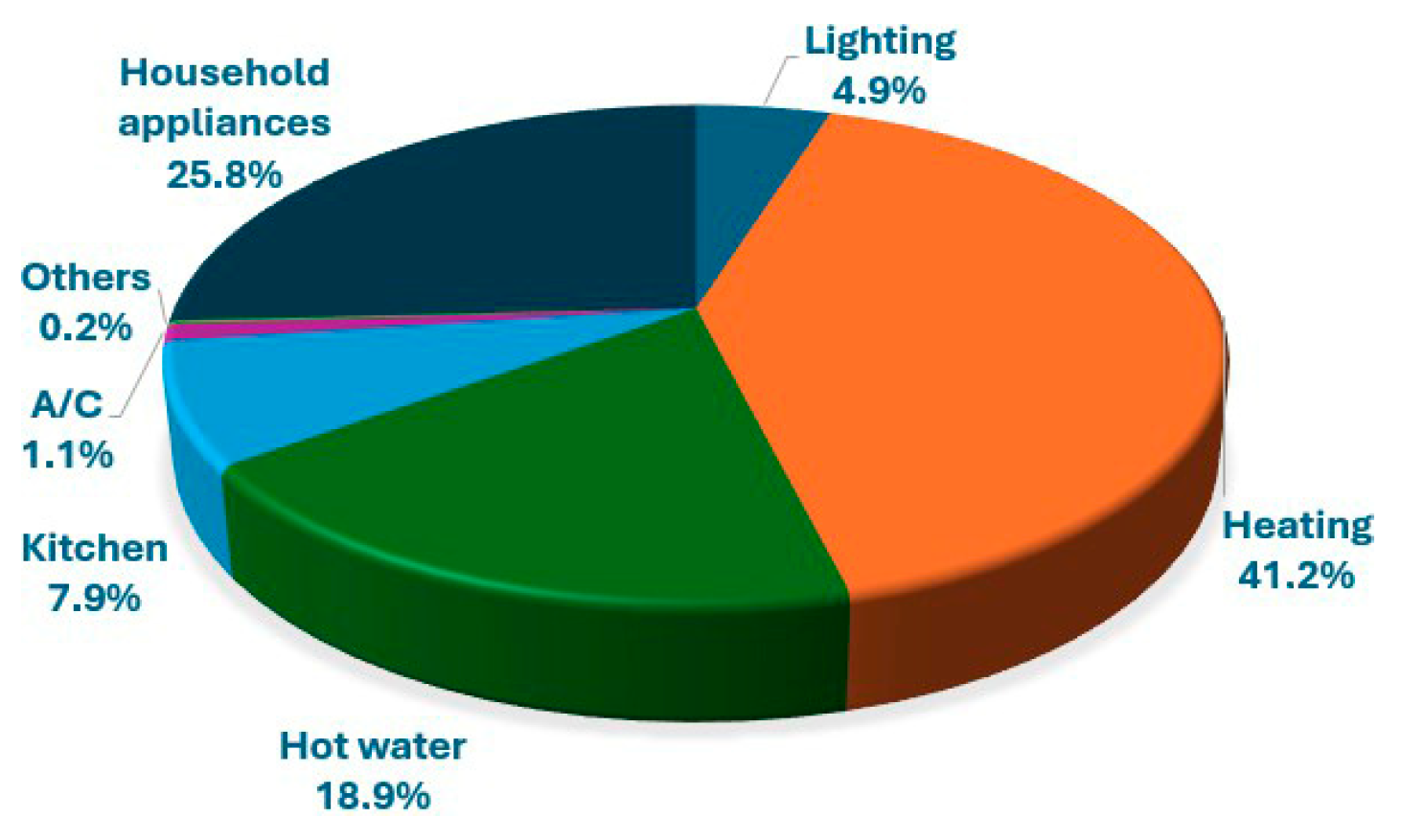


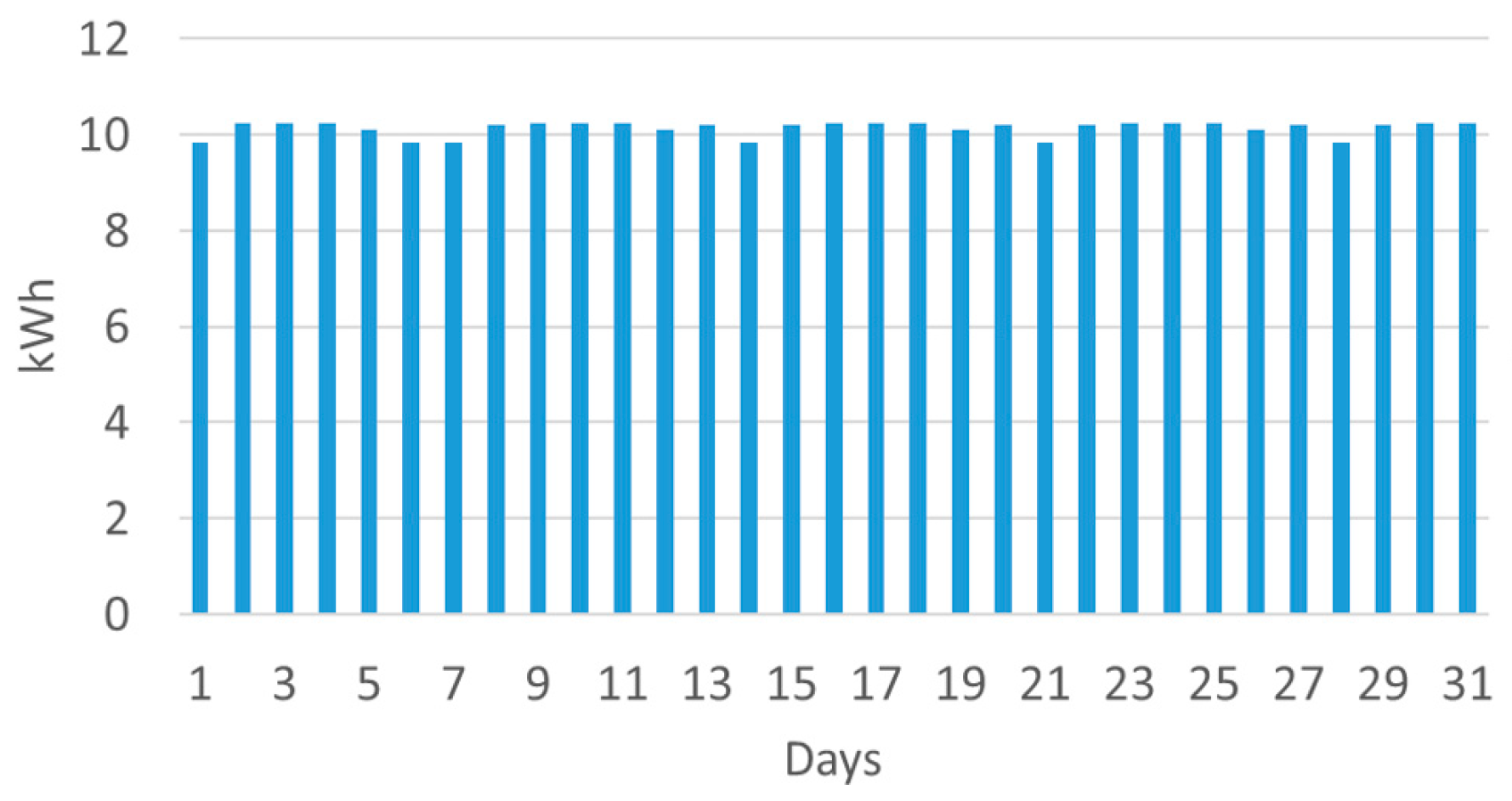

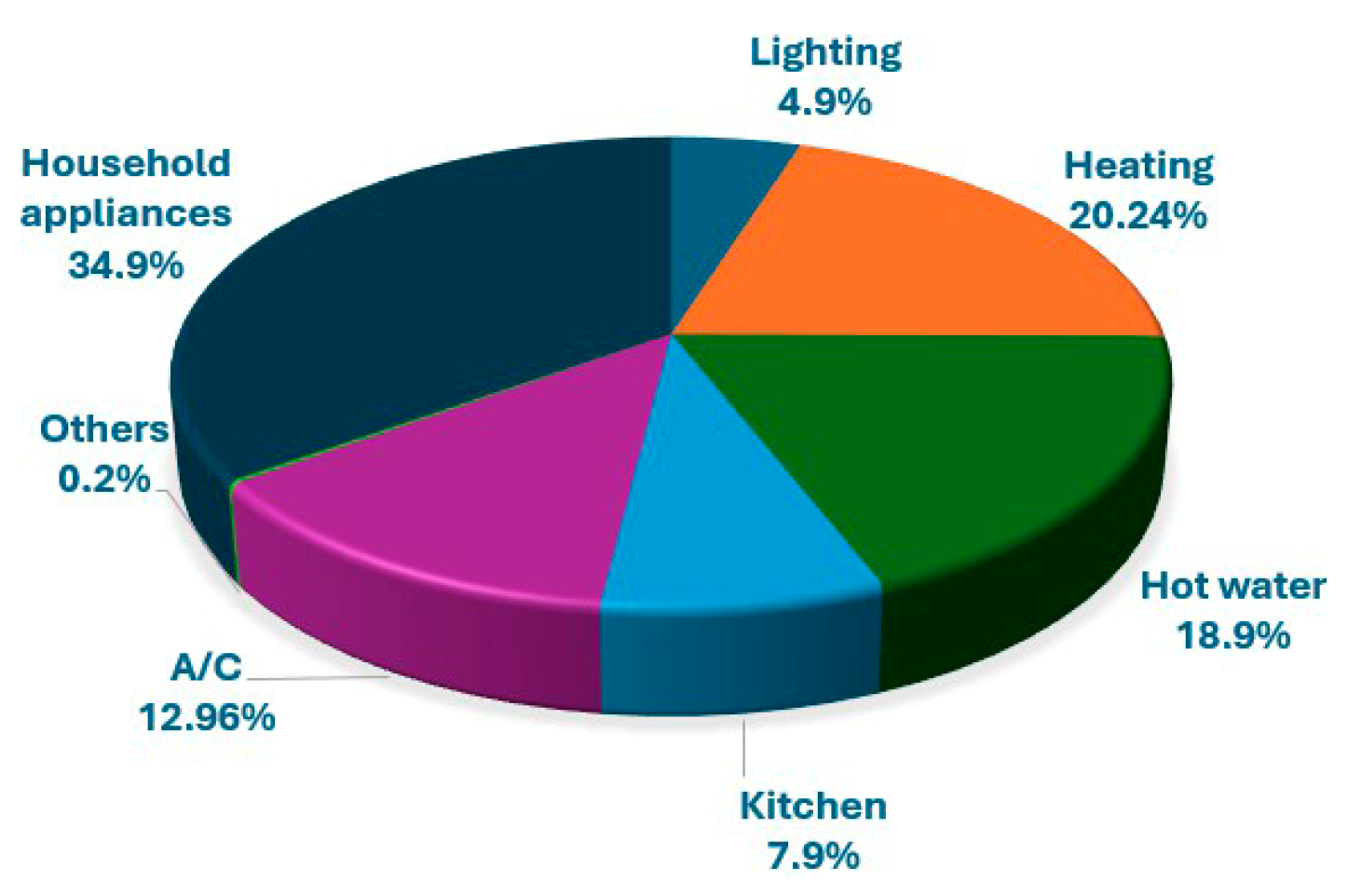
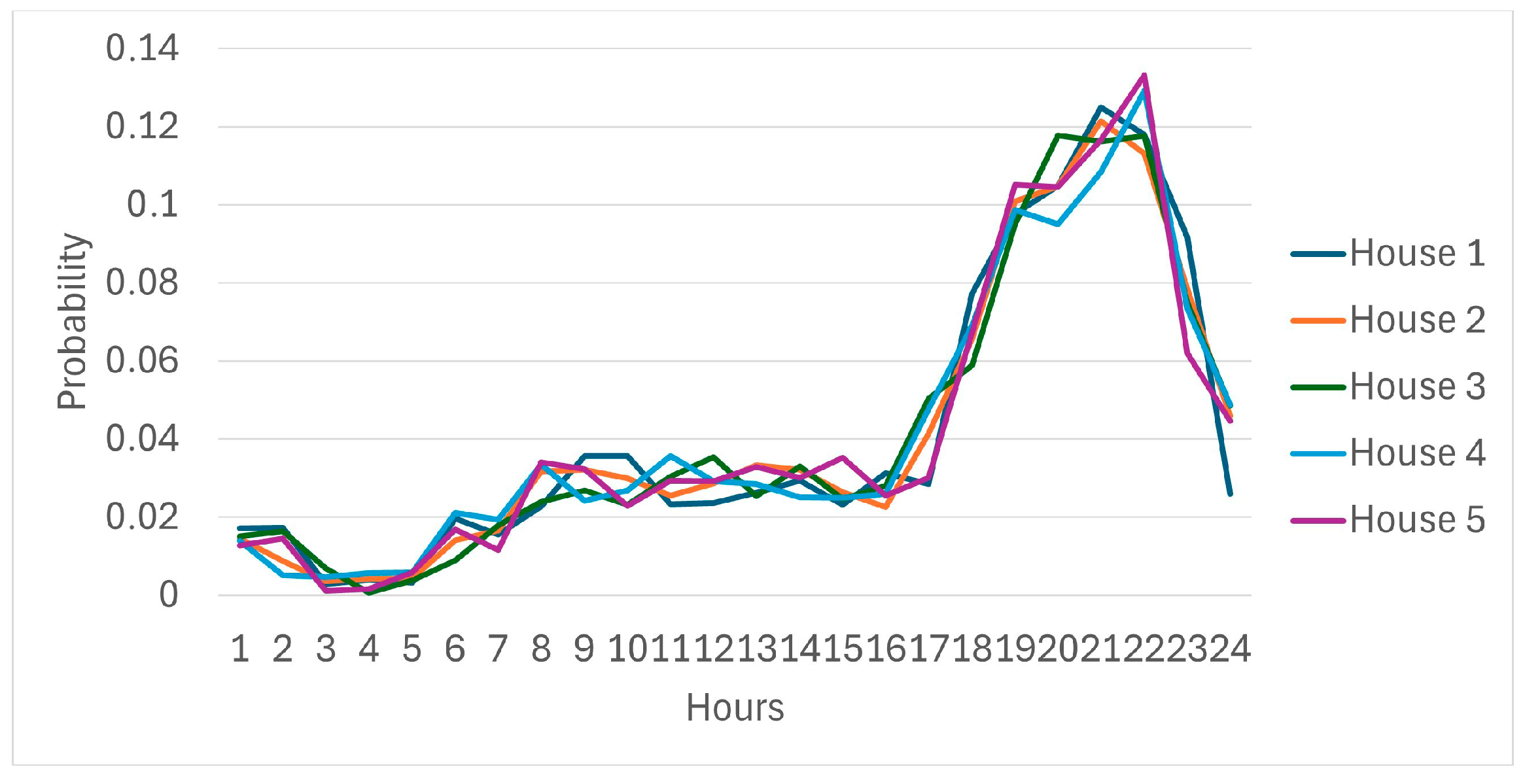



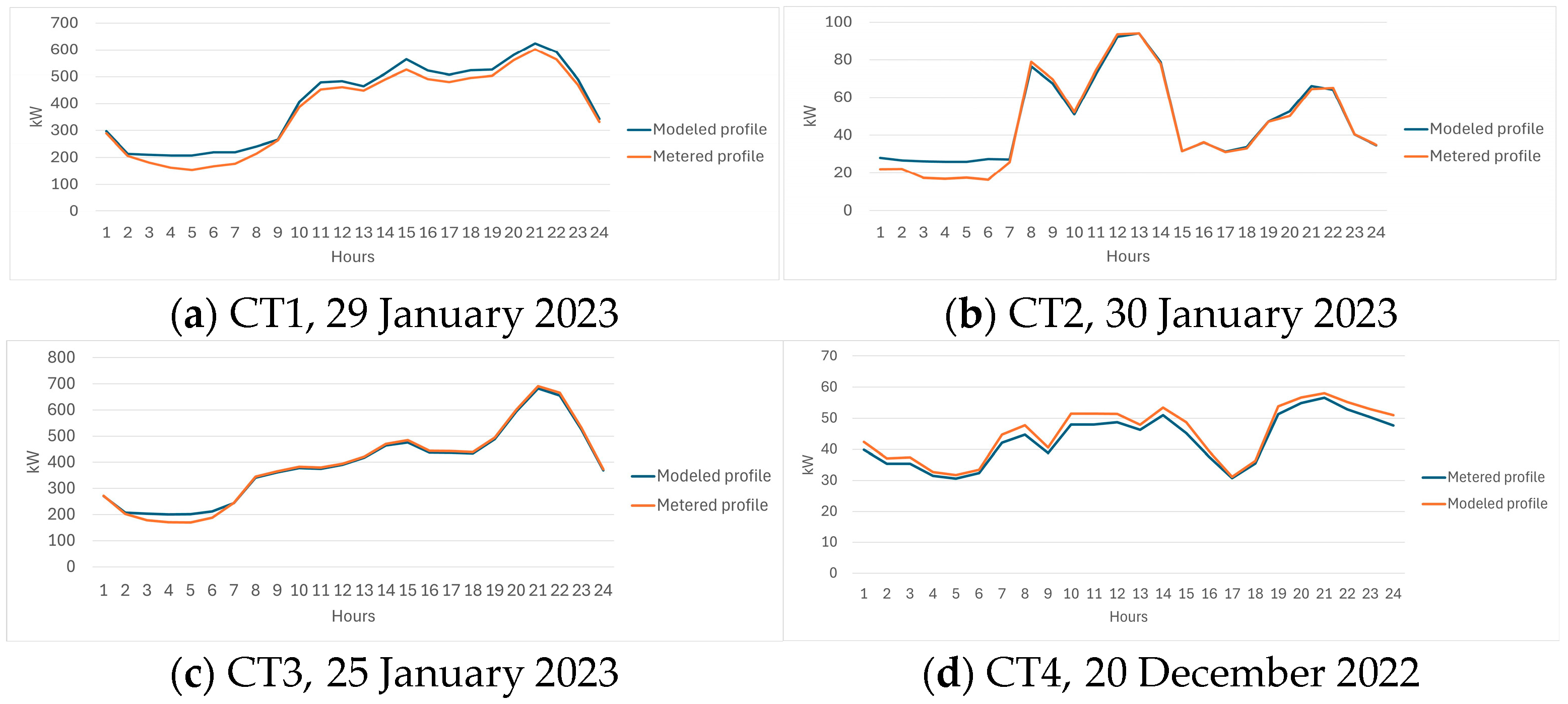
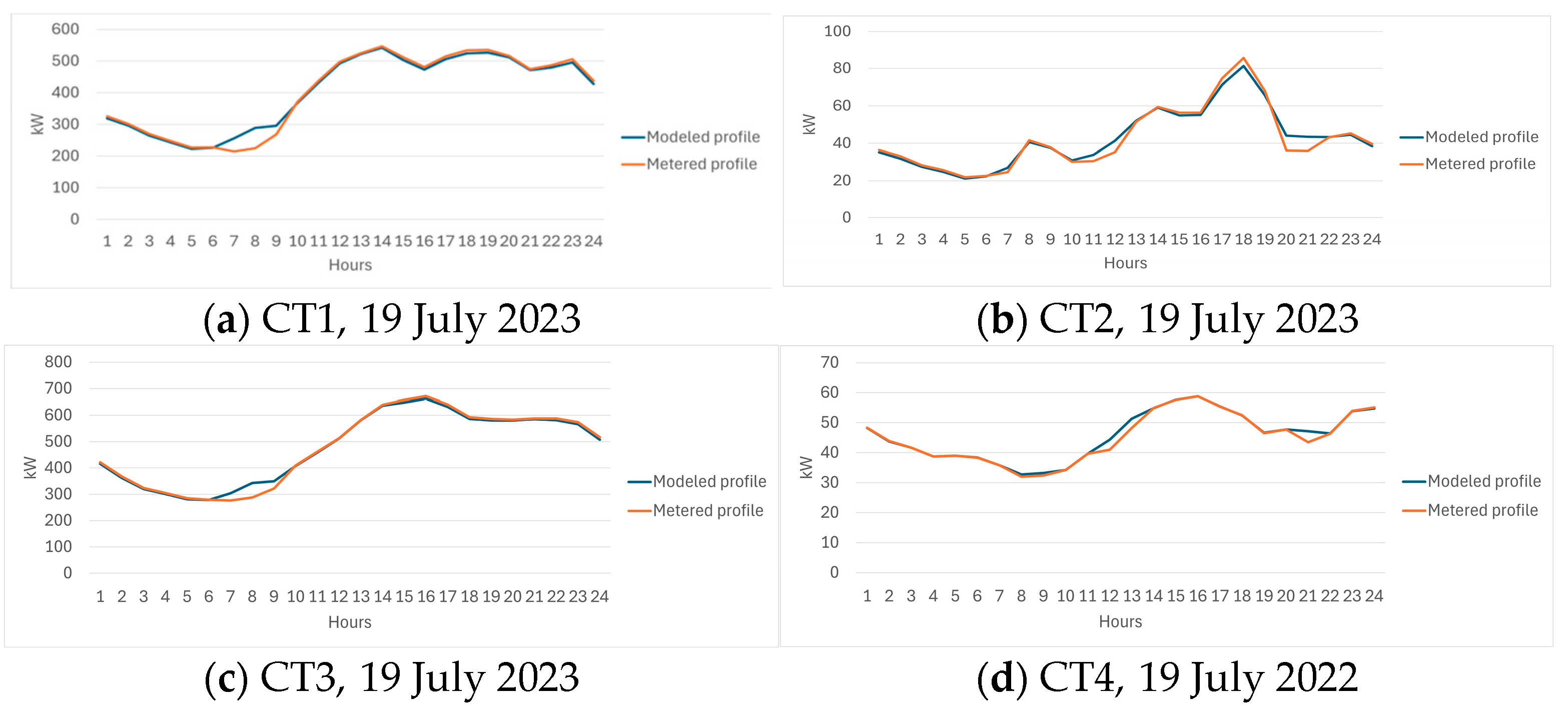

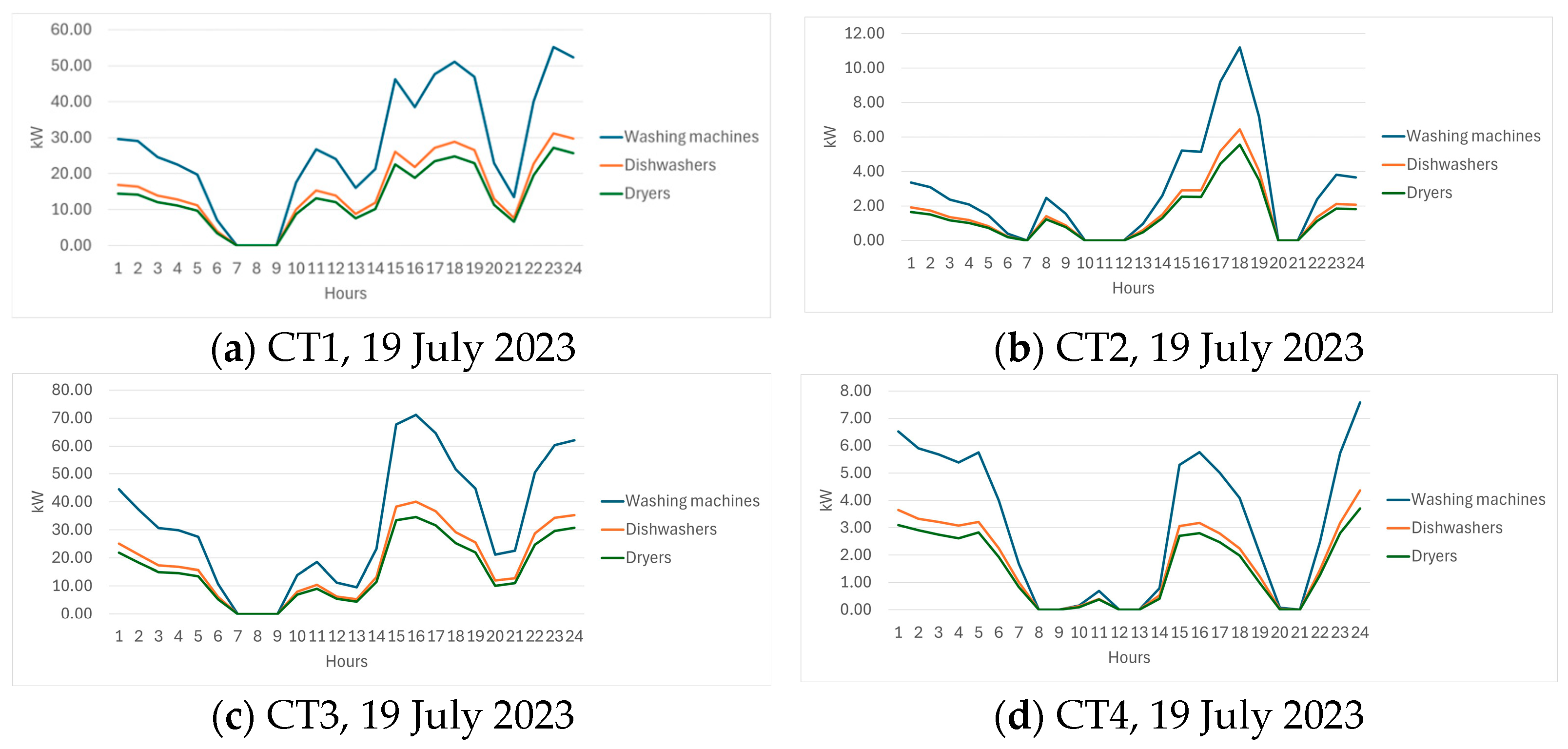
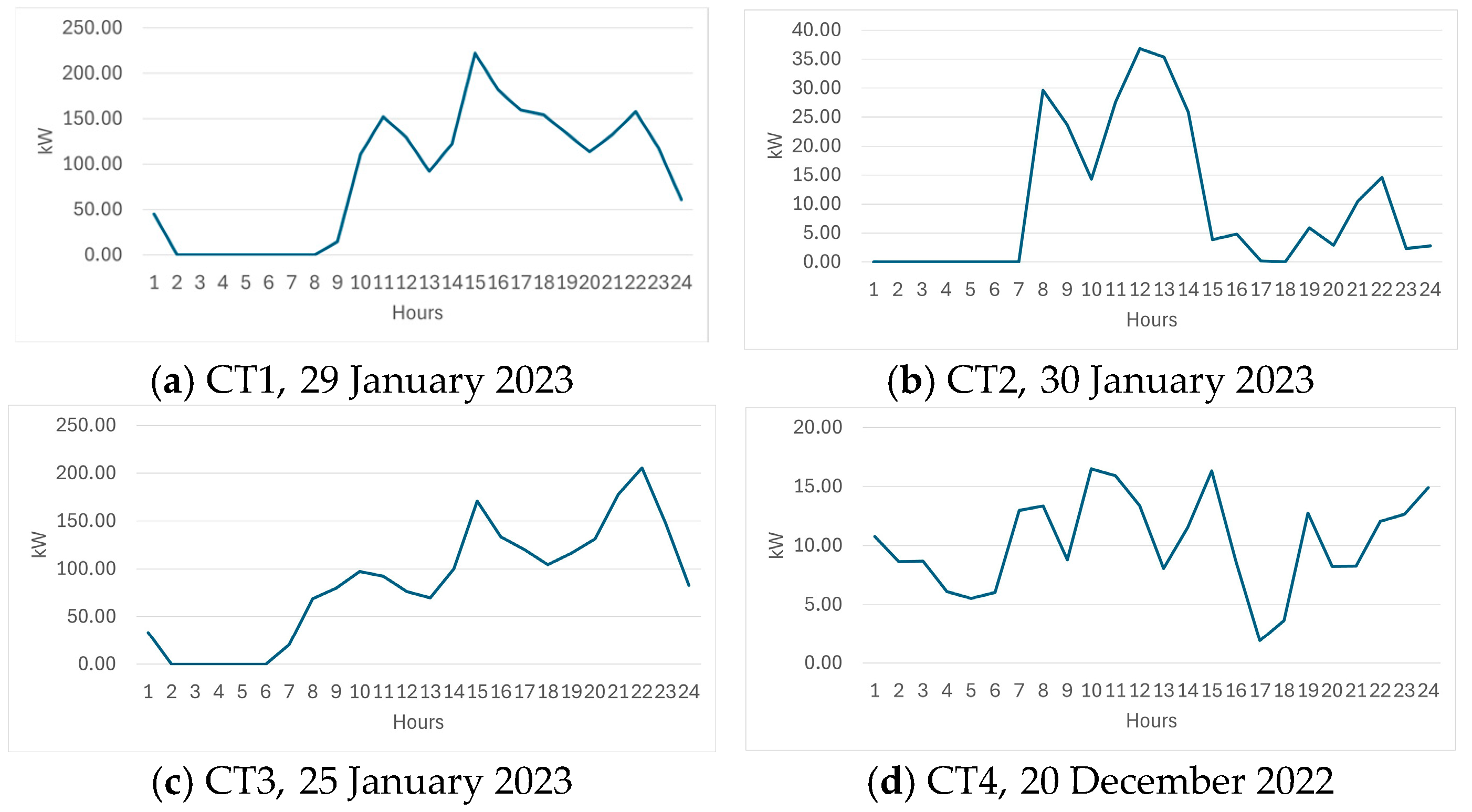
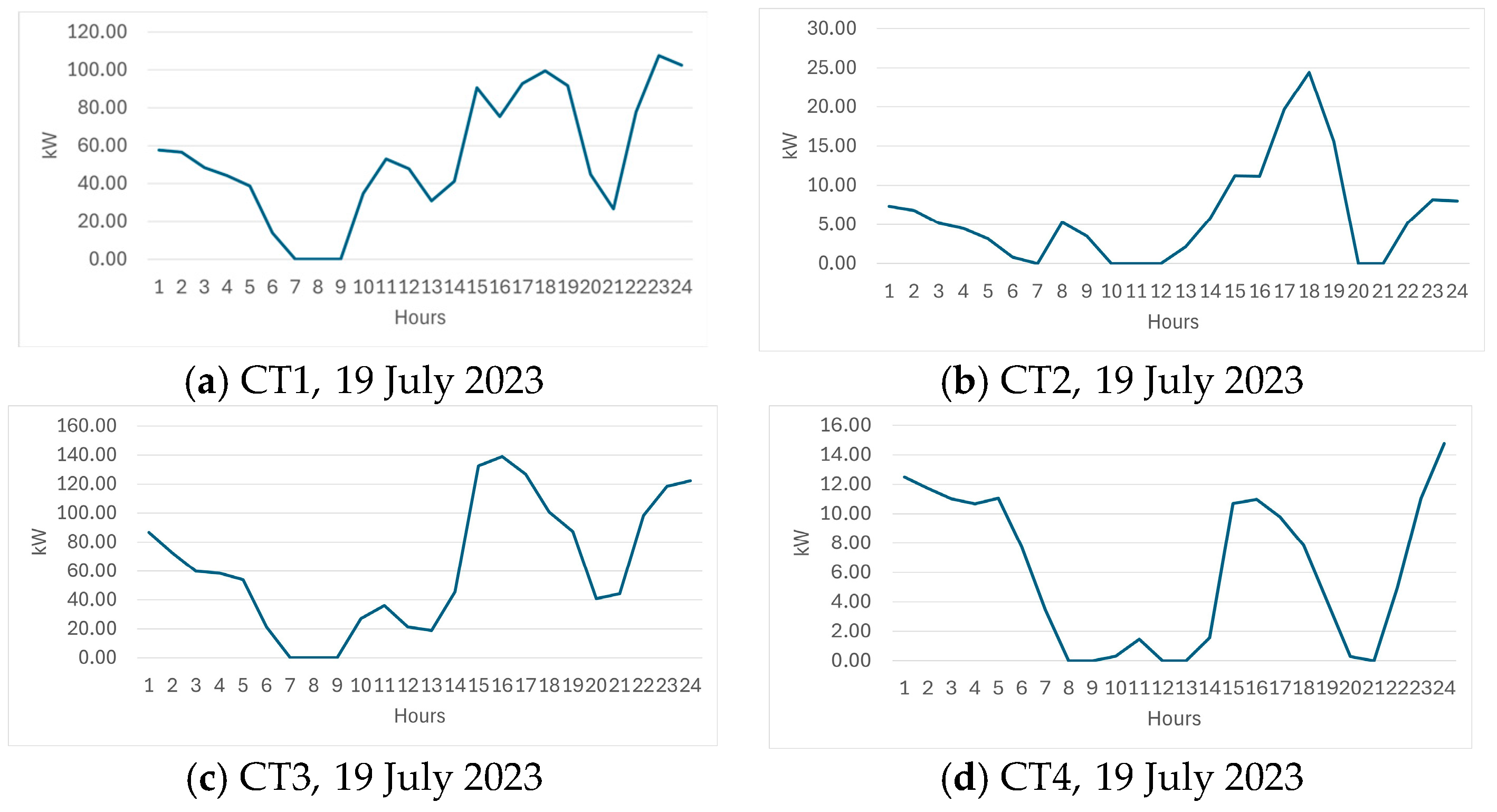
| Jan | Feb | Mar | Apr | May | Jun | |
|---|---|---|---|---|---|---|
| Lighting | 5.70% | 5.61% | 4.98% | 4.57% | 4.06% | 4.86% |
| Heating | 36.59% | 35.38% | 35.20% | 25.28% | 7.57% | 0.00% |
| Hot water | 21.66% | 18.93% | 18.27% | 21.46% | 25.42% | 15.99% |
| Kitchen | 6.40% | 7.10% | 7.63% | 8.97% | 9.38% | 11.22% |
| Air conditioning | 0.00% | 0.00% | 0.00% | 0.00% | 6.87% | 19.66% |
| Others | 0.21% | 0.18% | 0.20% | 0.23% | 0.27% | 0.27% |
| Television | 2.76% | 3.41% | 3.04% | 3.55% | 3.83% | 4.34% |
| Freezers | 1.32% | 1.41% | 1.52% | 1.68% | 2.11% | 2.17% |
| Refrigerators | 6.39% | 7.09% | 7.63% | 8.96% | 10.62% | 10.88% |
| Oven | 1.78% | 1.92% | 2.07% | 2.43% | 2.89% | 2.42% |
| Washing machines | 5.81% | 6.76% | 6.87% | 8.07% | 9.45% | 10.11% |
| Dishwashers | 3.65% | 4.36% | 4.30% | 5.05% | 5.99% | 6.19% |
| Computers | 1.75% | 1.89% | 1.85% | 2.16% | 2.57% | 2.66% |
| Dryers | 3.37% | 3.49% | 3.78% | 4.43% | 5.26% | 5.41% |
| Stand-by | 2.60% | 2.46% | 2.67% | 3.13% | 3.71% | 3.83% |
| Jul | Aug | Sep | Oct | Nov | Dec | |
|---|---|---|---|---|---|---|
| Lighting | 3.59% | 4.23% | 5.57% | 5.22% | 6.62% | 4.99% |
| Heating | 0.00% | 0.00% | 7.19% | 21.69% | 30.52% | 34.21% |
| Hot water | 13.16% | 13.12% | 21.23% | 22.32% | 18.71% | 23.12% |
| Kitchen | 7.54% | 7.74% | 8.88% | 9.33% | 7.82% | 6.82% |
| Air conditioning | 44.40% | 42.69% | 17.76% | 0.00% | 0.00% | 0.00% |
| Others | 0.14% | 0.20% | 0.23% | 0.24% | 0.20% | 0.17% |
| Television | 2.38% | 2.13% | 3.53% | 3.72% | 3.90% | 3.25% |
| Freezers | 1.45% | 1.54% | 1.71% | 1.86% | 1.56% | 1.36% |
| Refrigerators | 7.53% | 7.73% | 8.87% | 9.32% | 7.82% | 6.82% |
| Oven | 1.99% | 2.09% | 2.40% | 2.53% | 2.50% | 1.85% |
| Washing machines | 6.73% | 6.37% | 7.98% | 8.40% | 7.24% | 6.15% |
| Dishwashers | 3.82% | 4.15% | 5.00% | 5.26% | 4.41% | 3.85% |
| Computers | 1.77% | 1.48% | 2.14% | 2.25% | 1.89% | 1.65% |
| Dryers | 3.30% | 3.83% | 4.39% | 4.61% | 4.07% | 3.37% |
| Stand-by | 2.20% | 2.71% | 3.10% | 3.26% | 2.73% | 2.39% |
Disclaimer/Publisher’s Note: The statements, opinions and data contained in all publications are solely those of the individual author(s) and contributor(s) and not of MDPI and/or the editor(s). MDPI and/or the editor(s) disclaim responsibility for any injury to people or property resulting from any ideas, methods, instructions or products referred to in the content. |
© 2025 by the authors. Licensee MDPI, Basel, Switzerland. This article is an open access article distributed under the terms and conditions of the Creative Commons Attribution (CC BY) license (https://creativecommons.org/licenses/by/4.0/).
Share and Cite
Lamanna, C.; Oná-Ayécaba, A.O.; Montuori, L.; Alcázar-Ortega, M.; Rodríguez-García, J. Design of a Methodology to Evaluate the Energy Flexibility of Residential Consumers to Enhance Household Demand Side Management: The Case of a Spanish Municipal Network. Appl. Sci. 2025, 15, 7827. https://doi.org/10.3390/app15147827
Lamanna C, Oná-Ayécaba AO, Montuori L, Alcázar-Ortega M, Rodríguez-García J. Design of a Methodology to Evaluate the Energy Flexibility of Residential Consumers to Enhance Household Demand Side Management: The Case of a Spanish Municipal Network. Applied Sciences. 2025; 15(14):7827. https://doi.org/10.3390/app15147827
Chicago/Turabian StyleLamanna, Caterina, Andrés Ondó Oná-Ayécaba, Lina Montuori, Manuel Alcázar-Ortega, and Javier Rodríguez-García. 2025. "Design of a Methodology to Evaluate the Energy Flexibility of Residential Consumers to Enhance Household Demand Side Management: The Case of a Spanish Municipal Network" Applied Sciences 15, no. 14: 7827. https://doi.org/10.3390/app15147827
APA StyleLamanna, C., Oná-Ayécaba, A. O., Montuori, L., Alcázar-Ortega, M., & Rodríguez-García, J. (2025). Design of a Methodology to Evaluate the Energy Flexibility of Residential Consumers to Enhance Household Demand Side Management: The Case of a Spanish Municipal Network. Applied Sciences, 15(14), 7827. https://doi.org/10.3390/app15147827








